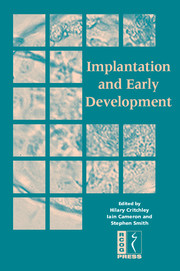Book contents
- Frontmatter
- Contents
- DECLARATION OF INTEREST
- Participants
- Preface
- SECTION 1 PREPARATION FOR IMPLANTATION – THE UTERINE ENVIRONMENT
- SECTION 2 THE EMBRYO
- SECTION 3 LESSONS FROM ANIMAL MODELS (TRANSGENICS) AND NOVEL TECHNOLOGIES
- SECTION 4 CLINICAL SEQUELAE
- 17 Sporadic early pregnancy loss: aetiology and management
- 18 Recurrent miscarriage – the role of prothrombotic disorders
- 19 Reproductive disorders and pregnancy outcome
- 20 Risk factors for first-trimester miscarriage: summary of results from the National Women's Health Study
- 21 Single-embryo transfer
- 22 Paediatric outcome after assisted reproductive technology
- SECTION 5 CONSENSUS VIEWS
- Index
21 - Single-embryo transfer
from SECTION 4 - CLINICAL SEQUELAE
Published online by Cambridge University Press: 05 June 2014
- Frontmatter
- Contents
- DECLARATION OF INTEREST
- Participants
- Preface
- SECTION 1 PREPARATION FOR IMPLANTATION – THE UTERINE ENVIRONMENT
- SECTION 2 THE EMBRYO
- SECTION 3 LESSONS FROM ANIMAL MODELS (TRANSGENICS) AND NOVEL TECHNOLOGIES
- SECTION 4 CLINICAL SEQUELAE
- 17 Sporadic early pregnancy loss: aetiology and management
- 18 Recurrent miscarriage – the role of prothrombotic disorders
- 19 Reproductive disorders and pregnancy outcome
- 20 Risk factors for first-trimester miscarriage: summary of results from the National Women's Health Study
- 21 Single-embryo transfer
- 22 Paediatric outcome after assisted reproductive technology
- SECTION 5 CONSENSUS VIEWS
- Index
Summary
Introduction
In vitro fertilisation (IVF) is the treatment of choice in couples with persistent infertility. In the UK, over 25000 IVF cycles were performed in a 12-month period between 2000 and 2001. In recent years, advances in clinical and laboratory skills have led to increased pregnancy rates of 30—40% per cycle of treatment. At the same time, routine transfer of multiple embryos has amplified the risk of multiple pregnancy. Over half of all infants born as a result of IVF are twins, triplets or higher order multiples. In the USA, where three embryos are still commonly transferred, the multiple pregnancy rate is 39%. In Europe, wider acceptance of a two embryo transfer policy has resulted in fewer triplets but the current twin pregnancy rate of 25% remains unacceptably high when compared with a population-based incidence of 1.25%.
Consequences of twin pregnancy
Twin pregnancies are associated with higher maternal and perinatal morbidity and mortality. In comparison with singletons, twins face a six-fold increased risk of mortality and permanent handicap owing to cerebral palsy, chronic lung dysfunction, blindness, learning difficulties and behavioural disorders. Maternal complications such as miscarriage, pregnancy-induced hypertension, gestational diabetes, premature labour and abnormal delivery are also more common. Stress associated with rearing twins and increased costs of prenatal and neonatal intensive care are also significant health service issues. Daily hospital charges have been shown to increase from $591 for a singleton delivery to $996 for each twin.
Keywords
- Type
- Chapter
- Information
- Implantation and Early Development , pp. 256 - 267Publisher: Cambridge University PressPrint publication year: 2005

